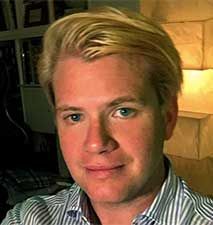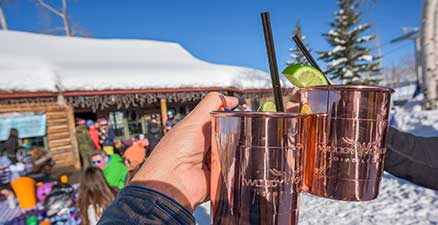Herbert Bayer’S Magic Carpet Now At Elk Camp

Part of the Bauhaus100: Aspen, a valley-wide, year-long celebration of the German school’s important influence on the development of Aspen.
Amongst certain factions of the art world, there are two places artists never wants their art to hang: in a lobby or in a restaurant. For Herbert Bayer’s Untitled wool-pile tapestry recently installed at Snowmass’s Elk Camp Restaurant, that’s 0 for 2.
And yet Bayer (1900–1985) would balk at such judgments. The Austrian/American graphic designer, painter, photographer, sculptor, art director, environmental designer, interior designer and architect—not to mention, Aspen’s “creative director,” and last living master of the Bauhaus—was something of the original lobby artist. He worked at a time when the collaboration between corporate America and contemporary art was quite new and unexpected.
Michelangelo had the Pope. Bayer had box mogul Walter Paepcke and oil man Robert O. Anderson. The latter commissioned the Elk Camp tapestry for one of his many ARCO corporate lobbies. It eventually found its way to the collection of the Aspen Institute and then up the gondola to its current spot overlooking the bustling lunch crowds at Elk Camp.
And yet Bayer (1900–1985) would balk at such judgments. The Austrian/American graphic designer, painter, photographer, sculptor, art director, environmental designer, interior designer and architect—not to mention, Aspen’s “creative director,” and last living master of the Bauhaus—was something of the original lobby artist. He worked at a time when the collaboration between corporate America and contemporary art was quite new and unexpected.
Michelangelo had the Pope. Bayer had box mogul Walter Paepcke and oil man Robert O. Anderson. The latter commissioned the Elk Camp tapestry for one of his many ARCO corporate lobbies. It eventually found its way to the collection of the Aspen Institute and then up the gondola to its current spot overlooking the bustling lunch crowds at Elk Camp.

Herbert Bayer’s Magic Carpet at Elk Camp Restaurant in Snowmass, Colorado.
Spanning 176 (14.6 feet / 4.45 meters) by 95 inches, the rug-like tapestry covers familiar Bayerian territory. A massive field of deep royal blue is flanked by undulating stripes of grays and pinks. A six-pointed star floats center left, made up of twelve multi-colored triangles and one red parallelogram, with a second faint circular figure center right. Bayer was devoted to (obsessed with?) the meeting of geometry and organic nature. How fitting then that the mighty peaks of Snowmass loom out the window.
The installation is part of the Bauhaus100: Aspen, a year-long celebration of Aspen’s significant connection to the German school, founded 100 years ago. No institution has affected the course of twentieth-century art and design so profoundly as the Bauhaus. Everything from our skylines to our dinner forks have roots in the Bauhaus. A member of the Art Directors Hall of Fame, Herbert Bayer represented the quintessential Bauhaus artist. Recruited by Paepcke to oversee the rebirth of Aspen into a mind-body-spirit utopia, Bayer set the stage for the “Aspen Idea.” He designed the Aspen Institute Campus, renovated the Wheeler Opera House and Hotel Jerome, designed the original Sundeck, founded the International Design Conference, and created all the graphics for the Ski Corporation and Music Festivals.
Aspen Snowmass continues to champion contemporary art. In addition to traditional art installations, for the last 14 years we have commissioned artists to take over the back of the lift tickets as their own little mini canvas. This year features the work of Hank Willis Thomas in a series entitled Fair Warning. The six part series features text-based works from old cigarette advertisements. Read all about it here.
And do take a moment to ponder the text on the back of your lift ticket as you lunch under Bayer’s beautiful tapestry.
The installation is part of the Bauhaus100: Aspen, a year-long celebration of Aspen’s significant connection to the German school, founded 100 years ago. No institution has affected the course of twentieth-century art and design so profoundly as the Bauhaus. Everything from our skylines to our dinner forks have roots in the Bauhaus. A member of the Art Directors Hall of Fame, Herbert Bayer represented the quintessential Bauhaus artist. Recruited by Paepcke to oversee the rebirth of Aspen into a mind-body-spirit utopia, Bayer set the stage for the “Aspen Idea.” He designed the Aspen Institute Campus, renovated the Wheeler Opera House and Hotel Jerome, designed the original Sundeck, founded the International Design Conference, and created all the graphics for the Ski Corporation and Music Festivals.
Aspen Snowmass continues to champion contemporary art. In addition to traditional art installations, for the last 14 years we have commissioned artists to take over the back of the lift tickets as their own little mini canvas. This year features the work of Hank Willis Thomas in a series entitled Fair Warning. The six part series features text-based works from old cigarette advertisements. Read all about it here.
And do take a moment to ponder the text on the back of your lift ticket as you lunch under Bayer’s beautiful tapestry.
About The Author


